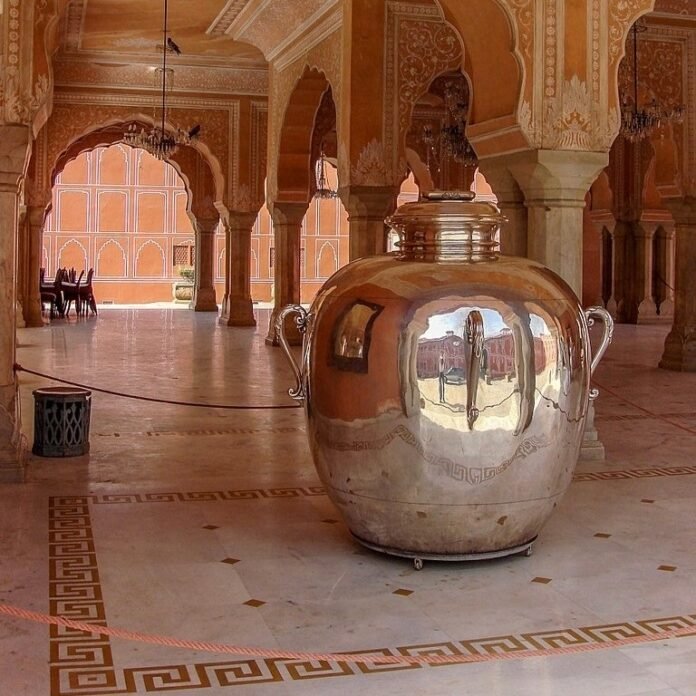
The City Palace in Jaipur houses two remarkable silver jugs that hold a unique place in history. These jugs were made by melting 40,000 silver coins, and what makes them even more special is that they were crafted without any joints. These magnificent urns were created under the direction of Maharaja Madho Singh II for his visit to London in 1902 to attend the coronation of King Edward VII.
Maharaja Madho Singh II was a devout Hindu who did not consider European water suitable for drinking and needed Ganges water for his religious ceremonies. These silver vessels, known as Gangajalis (Ganges water vessels), were filled with water from the River Ganges. The 8,000 liters of water stored in these jugs were sufficient for the Maharaja’s short visit to England. The pair of these grand water containers are now located in the private audience hall, the Diwan-i-Khas, at the City Palace in Jaipur.
Historical Significance and Construction
Ancient India was known for its silver artifacts, and during those days, silver was inexpensive, costing as low as one anna or six paisa per gram. Temples and royal palaces often had numerous silver items weighing several kilos. Among these, the most famous are the three heavy water jugs now kept in the City Palace of Jaipur. These jugs weigh 345 kg each, stand five feet three inches tall, and have a circumference of nearly 15 feet, with a carrying capacity of 4,091 liters each. According to the Guinness Book of World Records, these are the heaviest silver artifacts in the world.
The Jaipur state archives reveal that these jugs were made in 1894, after two years of labor by palace silversmiths. Although it is not known why these huge artifacts were originally made, they found their use within six years for Maharaja Madho Singh II’s journey to the United Kingdom to attend the coronation of King Edward VII in 1902.
Religious Dilemma and the Journey to England
Following the death of Queen Victoria in 1901, King Edward VII took over the British Empire and invited important Indian maharajas to his coronation. Maharaja Madho Singh II faced a religious dilemma as orthodox Hindus were not allowed to cross the ocean to Europe. The Maharaja consulted religious heads, who allowed him to travel under certain conditions: he would travel in a ship where no beef had ever been cooked or served, take idols of his family deity, spread earth from Jaipur under the deity’s throne and his bed, eat only prasad, and drink only Gangajal during his three-month stay in England.
The three huge silver jars from the Jaipur treasury became crucial for this journey as they could hold 4,091 liters of Ganges water each. The Maharaja’s travel agents chartered a newly completed ship, Olympia, ensuring no beef had ever been cooked or served on it. The entire arrangement, including the ship charter, cost a princely sum of Rs 1.5 million (equivalent to Rs 750 million today).
Six luxurious suites were prepared on the ship, one for the family deity Gopalji, one for the Maharaja, one for the royal priest, one for a close relative, and the remaining two for other members of the group. Ganga water stored in the jars was exclusively for the Maharaja and for preparing prasad for the family deity.
The Eventful Voyage
Before departure from Bombay, 25 Hindu priests conducted ceremonies to appease the presiding deity of the ocean, Lord Varuna. During the voyage, the ship encountered heavy storms in the Red Sea. The agitated priests advised the Maharaja to dump one of the three huge silver jars into the sea to calm Lord Varuna, which was done, and the seas calmed.
The voyage ended without further mishaps, and the British were astounded to see the huge silver jars. King Edward VII even made a personal visit to the Maharaja’s camp to see the jars. Today, these two silver jars are the star exhibits at the Sawai Man Singh City Palace Museum in Jaipur, attracting visitors from around the world to marvel at their grandeur and historical significance.

